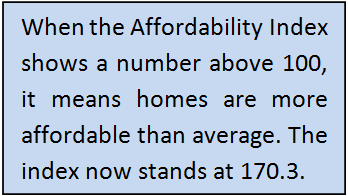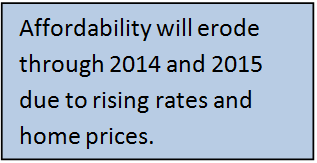Home buyers in 2014 will take advantage of one of the most affordable times in history for housing.
Each month the National Association of Realtors measures affordability using a proprietary Housing Affordability Index. The index compares how affordable homes are considering other economic factors like household income, interest rates, and home prices. The number 100 represents the point at which a family making the national median income can qualify for a median priced home when they put 20% down.
 A number below 100 means housing is less affordable; a number above 100 means the average family has more than enough income to buy the average home with 20% down.
A number below 100 means housing is less affordable; a number above 100 means the average family has more than enough income to buy the average home with 20% down.
In November 2013, the index stood at 170.3, meaning the average family has 1.7 times the income they need to buy the median priced home.
Take advantage of today’s affordability. See what purchase price you qualify for here.
Compare that to 64.8 as it was in May 1982, or more recently, 102.3 in June 2006.
Buyers in 2014 may not realize it, but home buying is incredibly affordable.
Home Prices are Just One Aspect of Affordability
The price of the home is important but other factors play into affordability.
Interest rates
Mortgage rates are vitally important when it comes to affordability. Unless a home buyer can pay cash for a home, the interest rate he or she receives could mean the difference between an affordable home and one that’s nowhere near affordable.
 Consider this scenario: a buyer has budgeted $1,150 per month for his principal and interest payment. At a 4.5% interest rate, he could buy a home for $281,250 with 20% down. But at 5.5%, his maximum purchase price is only $251,250.
Consider this scenario: a buyer has budgeted $1,150 per month for his principal and interest payment. At a 4.5% interest rate, he could buy a home for $281,250 with 20% down. But at 5.5%, his maximum purchase price is only $251,250.
That’s an 11% reduction in purchase price due to a 1% increase in interest rate.
Interest rates are at historic lows, but are set to rise. Check today’s rates and lock in a rate for your home purchase here.
Household Income
No matter how low home prices and interest rates are, it doesn’t matter if a home buyer’s income is too low to qualify for a home loan – or if he has no job at all.
But employment is on the mend after years of turmoil. The unemployment rate is 6.7% at the time of this writing, down from 10.0% in October 2009.
Businesses are hiring again, and paying more. Online retailer Amazon.com added 32,000 jobs in 2012. The state of Texas saw an increase of 28,700 jobs in November 2013 alone, topped by California which saw an increase of 44,300 jobs in that month according to the Bureau of Labor and Statistics.
Personal income jumped 1.2% in the second quarter of 2013, and another 1.1% in the third quarter, says the Bureau of Economic Analysis.
While the U.S. employment and income is still far from robust, the amount of money flowing into real families is staying ahead of historic housing costs.
Take advantage of affordable homes by obtaining a pre-qualification here.
But Aren’t Home Prices Going Up?
Home prices bottomed out and started rising after March 2011. But they are still 20% below 2005 peak prices according to Forbes.
So while rock bottom prices and unending inventory of homes may be a thing of the past, prices are still low and deals can still be found.
 One reason for great deals: the housing crisis is not over. According to foreclosure analytics website RealtyTrac, there are still more than 1.2 million foreclosures on the market. Foreclosures make up 1 in every 487 homes in Maryland and 1 in every 409 homes in Florida.
One reason for great deals: the housing crisis is not over. According to foreclosure analytics website RealtyTrac, there are still more than 1.2 million foreclosures on the market. Foreclosures make up 1 in every 487 homes in Maryland and 1 in every 409 homes in Florida.
A home buyer saves an average of 38% with a foreclosure compared to a non-distressed sale.
But just because a home buyer is not interested or able to buy a foreclosure, these types of properties still assist in landing a great deal.
Distressed sales drag down open market prices of homes. Sellers who want to sell because they are moving or downsizing must price their homes to compete with foreclosures, short sales, and bank-owned homes. This housing phenomenon has helped keep all home prices low, in just about every area of the country.
So while prices are going up to some extent, they are still held at lower levels than would exist in a healthy market.
Check today’s mortgage rates for your home purchase.
Will Affordability get Better?
The three factors that have played into incredible affordability are low interest rates, low home prices, and decent household income.
While household income should rise and help affordability, interest rates and home prices will slowly but surely contribute to lower levels of housing affordability.
 As we move through 2014 and 2015, expect rates to gradually increase as the Federal Reserve decreases its Quantitative Easing program – the program that has kept mortgage rates artificially low over the past few years.
As we move through 2014 and 2015, expect rates to gradually increase as the Federal Reserve decreases its Quantitative Easing program – the program that has kept mortgage rates artificially low over the past few years.
And home prices are bouncing off incredible lows. It would be a real surprise if prices fell again. Home appreciation could slow, but depreciation seems very unlikely in 2014 and 2015.
If you’re looking to buy a home, take advantage of today’s incredibly high levels of affordability.
Get a Home Purchase Rate Quote
Affordability will probably never be better than it is right now. Take advantage of the current home buying environment – it will soon be a thing of the past.
To get a personalized rate quote to see what purchase price you qualify for, contact a lending professional here.


